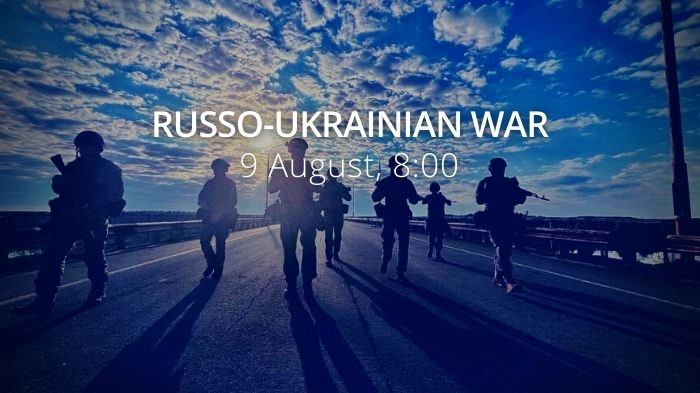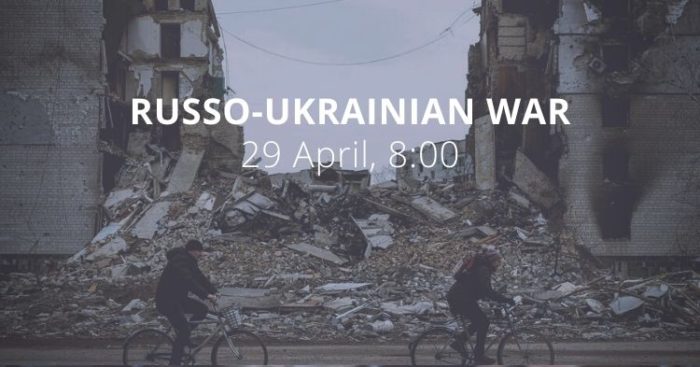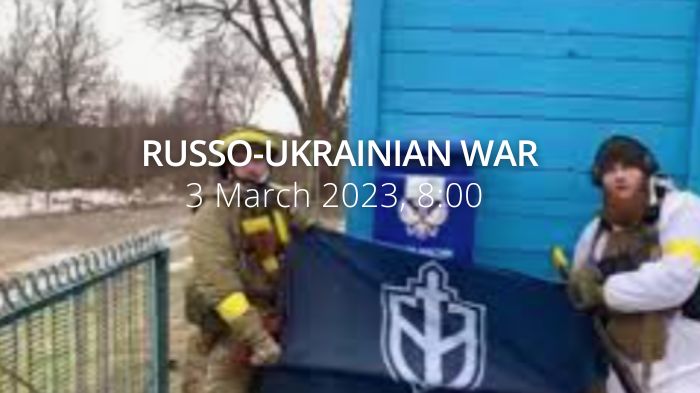Ukraine calls for the UN, IAEA to send security mission to Zaporizhzhia NPP. Russia and Ukraine agree to protect the grain shipping channel. Russia continued to focus efforts on reinforcing defenses in southern Ukraine. At least 17.7mn people in Ukraine will need humanitarian assistance this year. $1 Billion in Additional Security Assistance for Ukraine
Daily overview — Summary report, August 9
The General Staff’s operational update regarding the Russian invasion as of 06.00 am, August 9, 2022 is in the dropdown menu below.
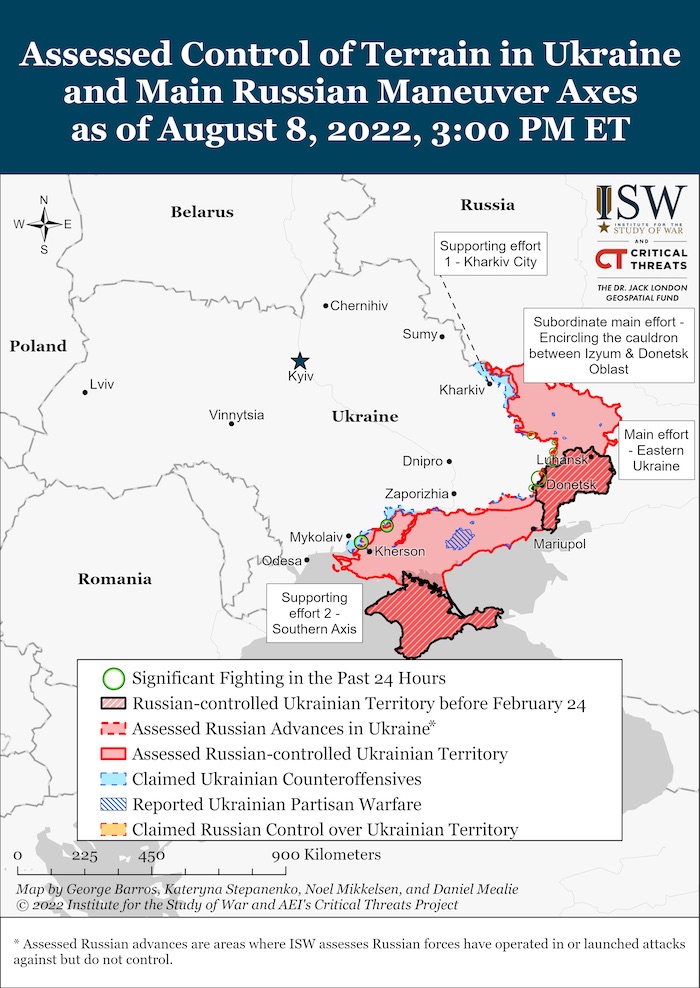
In the Volyn and Polissya directions, the situation did not undergo significant changes. The units of the Armed Forces of the Republic of Belarus continue to fulfil the tasks of strengthening the protection of the site of the Belarus-Ukrainian border in the Brest and Gomel regions.
The threat of missiles and airstrikes from the territory and airspace of the Republic of Belarus remains.
In the Siversky direction, Russian forces continue to keep separate units of the Western Military District troops in the border areas of the Bryansk and Kursk regions. They carry out demonstration actions to shake the manoeuvre of the units of our troops and prevent their transfer to other areas.
- Russian forces fired at our positions from the artillery and MLRS in the villages of Katerynivka villages, Seredyna-Buda and Mezenivka of Sumy oblast. It led air intelligence near Hay and Schalyhin. [Yesterday, Russian forces carried out artillery shelling in the areas of the settlements of Hremyach and Senkivka in Chernihiv oblast and Sukhodil, Manukhivka, Novi Vyrky and Pavlivka in Sumy oblast. Conducted aerial reconnaissance of border areas with unmanned aerial vehicles.]
In the Slobozhansky direction, Russian forces are fighting to keep previously occupied borders and prevent the offensive of Ukrainian soldiers, Russian forces try to reveal the construction of the system of defence of our troops.
National Guard & Armed Forces of Ukraine destroyed the base of Russian SOFs & ammunition depot in the north of Kharkiv Oblast
Reconnaissance discovered the base, recorded the fact of unloading ammunition, then guided the fire, National Guard said with📹 https://t.co/9BEen37UBa pic.twitter.com/69OqaHtxZD
— Euromaidan Press (@EuromaidanPress) August 8, 2022
- In the Kharkiv direction, the occupiers fired from tanks, artillery and MLRS in areas of settlements Sosnivka, Duvanka, Prudanka, Dementiivka, Pytomnyk, Ruska Lozova, Cherkaski Tyshky, Petrivka, Bayrak, Stary Saltiv, Bazaliivka, Korobochkyne, Andriivka, Milove, Chuhuyiv, and Chepil. Led air intelligence. It struck an aviation strike near Verhniy Saltiv. [Yesterday, shelling was recorded in the areas of Uda, Svitlychne, Zolochiv, Slatyne, Nove, Borshchova, Ruski Tyshky, Tsyrkuny, Peremoha, Slobozhanske, Chervone, Husarivka and Asiivka. The occupiers carried out airstrikes near Husarivka, Verkhnyi Saltiv, and Bayrak, and also used UAVs for reconnaissance near Tsupivka and Ruski Tyshky.]
- In the Sloviansk direction, Russian forces fired artillery against the districts of Brazhkivka, Karnukhivka, Sulyhivka, Nova Dmytrivka, Protopopivka, Adamivka, Zalymana, Mazanivka and Dolyna. [Yesterday, Russian forces carried out fire damage from artillery near Velyka Komyshuvakha, Dmytrivka, Virnopilla, Rydne, Dibrivne, Hrushuvakha, Bohorodychny, Nortsivka, Krasnopilla, and Mykilske. Made an air strike near Zalyman.]
- [Yesterday, the occupiers unsuccessfully tried to improve the tactical position near Bohorodychne.]
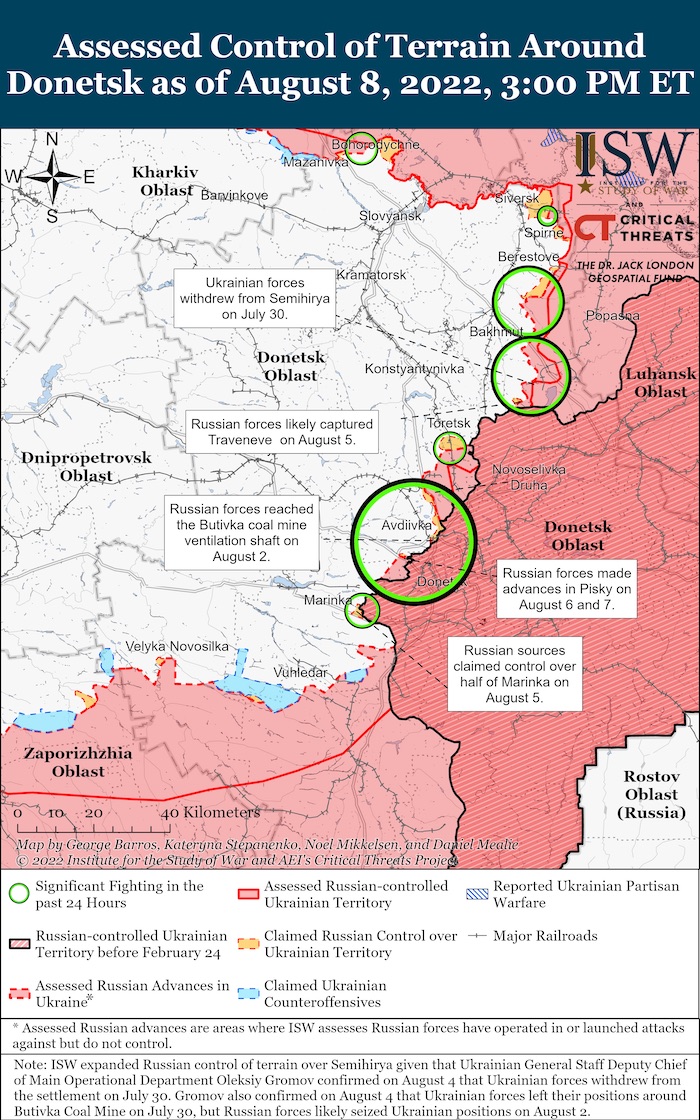
In the Donetsk direction, with the support of operational-tactical and army aviation, Russian forces conduct offensive battles in the Bakhmut and Avdiivka directions and try to displace our units from employed borders by artillery fire.
- In the Kramatorsk direction, Russian forces fired at Hryhorivka, Siversk, Verkhnokamyanske, Zakitne and Ivano-Dariivka. [Yesterday, Russian forces shelled the districts of Kramatorsk, Verkhnokamyanske Siversk, Hryhorivka, and Starodubivka from tanks, artillery and MLRS. Airstrikes near Hryhorivka and Ivano-Daryivka.]
- In the Bakhmut direction, there was recorded enemy artillery fire towards Soledar, Kodema, Bilohorivka, Bakhmutske, Vyjimka, Vershyna. Near Vershyna, as well as Zaitseve, Dacha, Bakhmut, Yakovlivka and Spirne enemy used aviation. [Yesterday, Russian forces fired at our troops near Bakhmut, Zaytseve, Yakovlivka, Krasnopolivka, Pokrovske and Vershyna It carried out airstrikes in the Bakhmut, Soledar and Kodema districts.]
- The invaders tried to reconnaissance by fighting in the areas of the settlements of Ivano-Dariivka, Vesele, Yakovlivka and Bakhmut. Ukrainian soldiers caused damage and forced the invaders to retreat. Russian forces attempted an offensive near Zaitseve with the same result. [Yesterday, Ukrainian soldiers repelled enemy assaults in the direction of the settlements of Bakhmut, Zaitseve, Vershyna and Kodema.]
- In the Avdiivka direction, shelling near Vodyane, Pislky, Nevelske, Novoselivka, Krasnohorivka and Sukha Balka beam was recorded. Russian forces struck in areas of settlements Marinka, Krasnohorivka, Novoselivka, Avdiivka. [Yesterday, artillery and tank shelling was recorded near Avdiivka, Opytny, Novobakhmutivka, Karlivka, Keramik and Kurakhove. Enemy aircraft operated near New York, Krasnohorivka and Mariinka.]
- Russian forces fought the offensive battles near Krasnohorivka and Avdiivka, but had no success, they retreated. [Yesterday, the attempt of the occupiers to advance in the direction of Avdiivka and Piski was stopped under the fire of Ukrainian soldiers. Russian forces retreated.]
- In the Novopavlivske and Zaporizhzhia directions, districts of settlements of Volodymyrivka, Pavlivka, Orikhiv, Shevchenko, Hulaypilske, Novodanylivka, Stepnohirsk, Olhiv, Kamianske and Novosilka were fired. Air strikes were recorded near Velyka Novosilka, Shcherbaky and Novosilka. [Yesterday, Russian forces used tanks, artillery and MLRS to fire at civil infrastructure objects in the areas of Novomykhailivka, Vugledar, Shevchenko, Hulyaipilske, Temyrivka, Vremivka, Hulyaipole, Malynivka and Novopilla settlements. Carried out airstrikes near Prechystivka, Volodymyrivka and Poltavka.]
- Our defenders neutralized intelligence groups in the areas of the Velyka Novosilka and Vremivka.
- [Yesterday, Russian forces tried to break through the defence of our troops in the direction of Mariinka and Shevchenko settlements, but were unsuccessful and retreated. Conducted aerial reconnaissance of the regions of the cities of Zaporizhzhia and Pavlohrad.]
In the Pivdenny Buh direction, Russian forces are conducting defensive operations. Actively uses army aviation. In order to shake our troops, it carried out artillery shelling in the areas of the settlements of Prybuzke, Posad-Poskrovske, Lupareve, Ukraiinka, Luch, Myrne, Blahodatne, Novorosiyske, Shyroke, Partyzanske, Plotnytske, Bilohirka, Osokorivka and Knyazivka. [Yesterday, Russian forces fired tanks and artillery of various types in the areas of Mykolaiv, Tavriyske, Lymany, Oleksandrivka, Kotlyareve, Novomykolaivka, Novohredneve, Kiselyvka, Kobzartsi, Kvitneve, Zeleny Hay, Andriivka, Ivanivka, Novooleksandrivka, Topolyne and Potemkyne settlements. They carried out airstrikes near Lozove Olhany, Andriyivka, and Tavriyske. Considerable attention is focused on aerial reconnaissance by unmanned aerial vehicles.]
- It struck airstrikes near the Bila Krynytsia, Andriivka, Osokorivka and Olhyne.
- It led air reconnasance of UAVs in the areas of Bilohirka, Murkhivka, Novooleksandrivka, Shevchenkove, and Mykolaivka.
[In the waters of the Black Sea, a Russian naval group concentrates its main efforts on supporting the actions of the land group of troops and attacking objects deep in the territory of Ukraine.] Two Russian warships with the "Kalibr" type are in the waters of the Black Sea in readiness for the use of high-precision weapons.
Russian aviation group conducts systematic fighting to support land groups. The effort focuses on the damage to military sites in the Donetsk direction.
Ukrainian aviation and rocket-artillery units continue the successful fire damage to the clusters of living power, military equipment of Russian invaders and ammunition depots. As a result of losses, Russian personnel in many directions refuses to fight and resorts to sabotage.
Ukrainian air forces destroyed all four Kalibr missiles that Russia launched from the Black sea in the morning.
1 missile was destroyed in the south while 3 over the center of Ukraine, Air Forces informed.
📹Remnants of the missile destroyed near Umanhttps://t.co/84QX2t87yt pic.twitter.com/zyHq7ZFqnQ— Euromaidan Press (@EuromaidanPress) August 8, 2022
[Yesterday, around 10 o'clock, the anti-aircraft missile units of the Air Force destroyed four sea-based cruise missiles of the "Calibre" type launched by Russian forces from the Black Sea. One missile was destroyed in Odesa by soldiers of the "South" air command, and three more were shot down by anti-aircraft missile units of the "Center" air command.]”
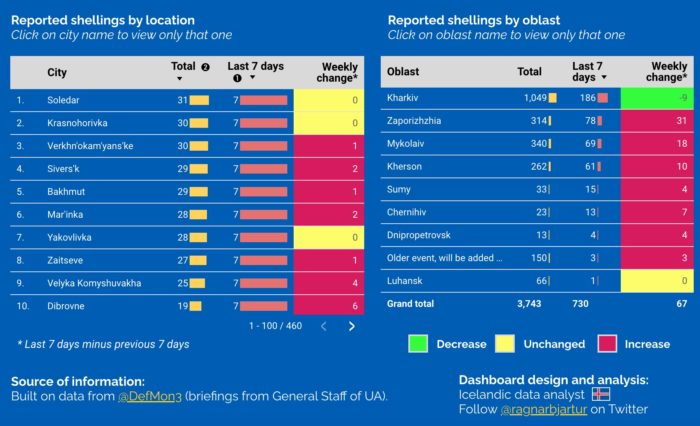
Military Updates
Vinnytsia was hit by Kh-47M2 Kinzhal (in Russian: Кинжал ("dagger"), NATO reporting name Killjoy) hypersonic missiles on Sunday, the Ukrainian General Staff reports. “On August 7, the Russian occupiers used Kh-47M "Kinjal" hypersonic air-based missiles at military facilities in the Vinnytsia region. The main carrier of missiles of this type is the MiG-31 fighter, but Tu-22M3 and Tu-160 bombers can also be used. This is the newest type of missile that Russia has in its arsenal. After being put into service in 2018, only a few dozen of them were released. The warhead of the Kh-47M is 500 kg.
After launching from the plane, the rocket rises to a great height in the upper layers of the atmosphere. And when approaching a target along a ballistic trajectory, it can develop a speed of about 12,000 km/h [9,8 mach]. The tactical and technical characteristics of this missile do not allow the air defence means existing in the Armed Forces of Ukraine to effectively detect and destroy it.
Since February 24, 2022, only a few combat applications of missiles of this type have been recorded, which Russian forces are trying to use on extremely important targets.”
Ukraine says its troops advance towards Izium as fighting rages in Donbas, Reuters reports. “Around Kharkiv in the northeast, Ukrainian troops captured the town of Dovhenke from Russian occupiers and were advancing towards Izium, Ukrainian Presidential adviser Oleksiy Arestovych said in a video posted on YouTube. "The situation is very interesting. Ukraine's forces are moving very successfully. Attempts by Russia to regain lost ground were not successful. Ukraine may end up encircling them," he said.
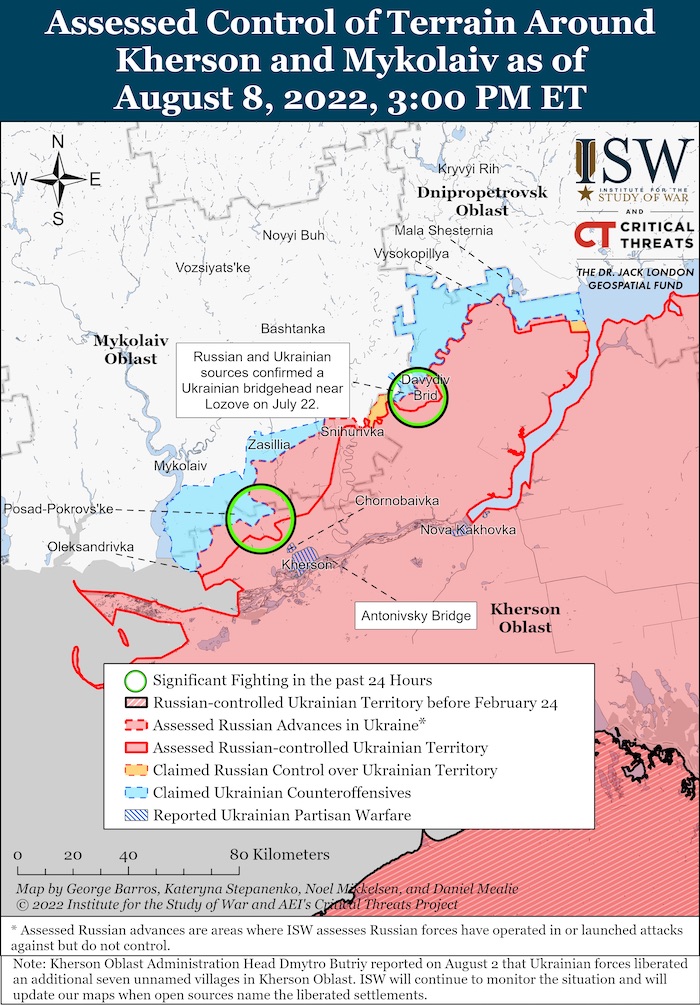
In the southeast, the key Antonovskyi bridge over the Dnipro river in the Kherson region was targeted again by Ukrainian forces trying to disrupt Russian supply lines. Yuri Sobolevsky, deputy head of Kherson regional council ousted by Russian occupation forces, said on Telegram the bridge had been seriously damaged after overnight actions.”
Ukraine says it caught hitmen on a Russian mission to kill top officials, Reuters reports. “Ukraine arrested two people working for Russian intelligence services who planned to kill Ukraine's defence minister and the head of its military intelligence agency, Ukraine's domestic security service, the SBU, said on Monday.”
Ukraine's & world IT-community started flash mob #RussiaIsATerroristState
The goal is to change the name "Russia" to "Russia terrorist state" on all sites & systems where it's possible to select a country or language. There are already first results: https://t.co/nlFn7TkGO8 pic.twitter.com/KD06PcJnUX
— Euromaidan Press (@EuromaidanPress) August 8, 2022
According to British Defence Intelligence, (last 48 hours):
- Over the weekend, Russia has continued to focus efforts on reinforcing defences in southern Ukraine. Despite the shift in effort, Russia has maintained attacks on Ukrainian positions in Donetsk oblast.
- Over the last 30 days, Russia’s assault towards the town of Bakhmut has been its most successful axis in the Donbas; however, Russia has only managed to advance about 10km during this time.
- In other Donbas sectors where Russia was attempting to break through, its forces have not gained more than 3km during this 30 day period; almost certainly significantly less than planned. Despite its continued heavy use of artillery in these areas, Russia has not been able to generate capable combat infantry in sufficient numbers to secure more substantial advances.
- Russia is highly likely deploying anti-personnel mines to protect and deter freedom of movement along its defensive lines in the Donbas. These mines have the potential to inflict widespread casualties amongst both the military and the local civilian population.
- In Donetsk and Kramatorsk, Russia has highly likely attempted employment of PFM-1 and PFM-1S scatterable anti-personnel mines. Commonly called the ‘butterfly mine’, the PFM-1 series are deeply controversial, indiscriminate weapons.
- PFM-1s were used to devastating effect in the Soviet-Afghan War where they allegedly maimed high numbers of children who mistook them for toys. It is highly likely that the Soviet-era stock being used by Russia will have degraded over time and are now highly unreliable and unpredictable. This poses a threat to both the local population and humanitarian mine clearance operations.
Losses of the Russian army
As of Tuesday 9 August, the approximate losses of weapons and military equipment of the Russian Armed Forces from the beginning of the war to the present day:
- Personnel – more than 42640 (+300),
- Tanks – 1817 (+6),
- Armoured combat vehicles – 4076 (+6),
- Artillery systems – 964 (+4),
- Multiple rocket launchers –MLRS - 261 (+0),
- Air defence means – 133 (+1),
- Aircraft - 223 (+0),
- Helicopters - 193 (+1),
- Automotive technology and fuel tanks – 2998 (+5),
- Vessels/boats - 15 (+0),
- UAV operational and tactical level – 757 (+3),
- Special equipment – 87 (+1),
- Mobile SRBM system – 4 (+0),
- Cruise missiles – 185 (+3),
Russian enemy suffered the greatest losses (of the last day) in the Bakhmut and Donetsk directions.
Pentagon estimates Russia’s casualties in Ukraine at about 80,000 killed and wounded, Ukrinform reports. “On precise figures, there is a lot of fog in war. But I think it’s safe to suggest the Russians have probably taken 70-80 thousand casualties in the last 6 months. That’s a combination of killed in action and wounded,” [US Under Secretary of Defense for Policy Colin] Kahl said. In his words, that is “pretty remarkable”, considering the Russians have achieved none of Putin’s objectives declared at the beginning of the war.”
⚰️russia's combat losses in Ukraine as of August 9
▪ 42640 killed soldiers (+300)
▪ 4076 APV (+6)
▪ 1817 tanks (+6)
▪ 964 artillery systems (+4)
▪ 223 aircraft and 193 helicopters (+1)
▪ 15 boats and cutters#StopRussia #StandwithUkraine pic.twitter.com/mxMMBBFQMx— VoxUkraine (@voxukraine) August 9, 2022
Humanitarian
At least 17.7M people in Ukraine will need humanitarian assistance this year, Ukrinform reports, citing the UN office in Ukraine. “Intense hostilities since the start of Russia's invasion on February 24 have left at least 17.7 million people in need of humanitarian assistance and protection, an increase of around 2 million people compared to April.
Over the last five months, we have seen how local, national and international humanitarian organizations have joined efforts across Ukraine to increase the scale and scope of operations and provide assistance to more than 11 million people. The reality is that more people need support, said [the Humanitarian Coordinator for Ukraine, Denise Brown], explaining that at least 17.7 million people - over a quarter of Ukraine's population - will need humanitarian aid in the months ahead.
This is an increase of about 2 million more than what we had estimated during the last revision of the Flash Appeal, in April, she added.”
Russia and Ukraine agree to protect the grain shipping channel, Reuters reports. “Ships exporting Ukraine grain through the Black Sea will be protected by a 10 nautical mile buffer zone, according to long-awaited procedures agreed by Russia, Ukraine, Türkiye and the United Nations on Monday and seen by Reuters. The initiative has been operating in a trial phase for the past two weeks. Ten ships - stuck in Ukraine since the war started - have departed with corn, soybeans and sunflower oil and meal. Two empty vessels have travelled to Ukraine to collect shipments. […]
Neil Roberts, head of marine and aviation at Lloyd's Market Association - which represents the interests of all underwriting businesses in the Lloyd's of London insurance market - told Reuters that the industry could now "play its part." […] The shipping and insurance industry wanted assurances of a secure journey with no threat of sea mines or attacks to their ships and crews. These are typically covered in standard operating procedures, which is what was agreed on Monday.
"The parties will not undertake any attacks against merchant vessels or other civilian vessels and port facilities engaged in this initiative," according to the 'procedures for merchant vessels' document. […] Under the agreed procedures, the JCC will provide information on the planned movement of ships through the maritime humanitarian corridor, which will be shared with Russia, Ukraine and Türkiye's military to prevent incidents.
Then as the vessel moves through the maritime humanitarian corridor it will be protected by a 10 nautical mile circle buffer zone around it. No military vessel, aircraft or UAVs (drones) will close to within 10 nautical miles of a merchant vessel transiting the Maritime Humanitarian Corridor, excluding territorial seas of Ukraine, according to the document.”
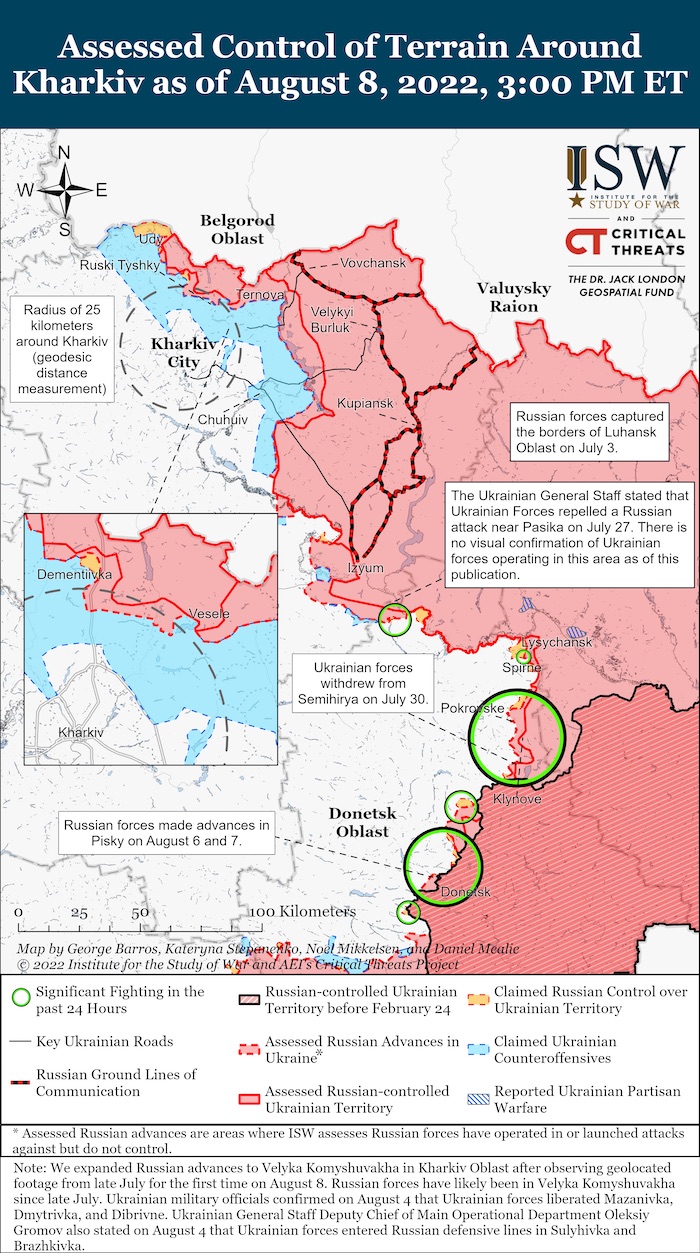
Russians damage Kharkiv thermal power plant which provides one-third of the city with heat, Ukrainska Pravda reports, citing Ukrinform. “Kharkiv's Thermal Power Plant-3, which provides heat for about a third of the city, has been damaged in a Russian attack, [according to Oleh Syniehubov, the head of the Kharkiv Oblast Military Administration].”

OHCHR recorded 12,867 civilian casualties in Ukraine as of August 8. 5,401 were killed (including 355 children) and 7,466 injured (including 580 children).
️️Environmental
Russian forces declare their readiness to blow up mined Zaporizhzhia NPP, Ukrinform reports, citing the press service of Energoatom National Nuclear Energy Generating Company. "The Russians do not hide their plans and are openly blackmailing the whole world, declaring that they have mined the Zaporizhzhia NPP and that they are ready to blow it up, the report reads.
According to Energoatom, the head of the radiation, chemical and biological defence troops of the Russian Federation, Major General Valeriy Vasiliev, who currently commands the ZNPP garrison, said that "there will be either Russian land or a scorched desert."
"As you know, we mined all the important facilities of the Zaporizhzhia nuclear power plant. We do not hide this from Russian forces. We warned them. Russian forces know that the plant will be either Russian or no one’s. We are ready for the consequences of taking this step. And you, soldiers-liberators, you must understand that we have no other way. And if there is the most severe order, we must fulfil it with honour," Vasiliev told his soldiers.
As Ukrinform reported, on July 6, Ukrainian intelligence confirmed information that the Russian army had mined power units of the Zaporizhzhia nuclear power plant.
Zaporizhzhia NPP contains 1,200 t of nuclear fuel – regional administration, Ukrinform reports. “If a nuclear incident occurs, not only southern Ukraine but also Crimea and Russia will be affected. A nuclear bomb contains nine kilograms of uranium or plutonium, and our plant has 1,200 tonnes. Contamination can be rather high but… it is ‘Russian roulette’, [Head of Zaporizhzhia Regional Military Administration, Oleksandr] Starukh said.”
Ukraine calls for UN, IAEA to send security mission to Zaporizhzhia NPP, Ukrinform reports, citing a statement published on the Ombudsman's Telegram channel. “Verkhovna Rada Commissioner for Human Rights Dmytro Lubinets has called for the Secretary General of the United Nations and the International Atomic Energy Agency (IAEA) to send a security mission to the Zaporizhzhia nuclear power plant occupied by Russian forces.”
https://twitter.com/EuromaidanPress/status/1556686683260694528
Legal
Ukrainian Prosecutor General's Office investigates 27,273 war-related crimes as of 8 Aug 2022 pic.twitter.com/XHeIWplwir
— Euromaidan Press (@EuromaidanPress) August 8, 2022
Amnesty International Assessment That Ukraine ‘Put Civilians in Harm’s Way’ Stirs Outrage, The New York Times reports. “Experts in the rules of war said there were no proscriptions against using schools, hospitals, museums and other public places as military command posts or bases, so long as they were not being used for their peacetime purposes. And the Ukrainian military has said that Russia’s prolonged shelling of towns and cities, like the eastern city of Kharkiv, has forced it to position its troops and artillery within neighbourhoods to properly defend them.
Neighbourhoods in Kharkiv have mostly emptied out, though some stalwart residents remain. But further east, in the industrial Donbas region where Russian forces have focused much of their firepower, more residents are choosing to stay behind. Ukrainian officials say this has left the country’s military in an increasingly tenuous position: They are putting more civilians in danger with their presence but, especially in bigger towns and cities, have fewer and fewer options when it comes to where they locate their forces. […]
Russian officials claim not to attack civilian areas, but Ukrainian and international investigators say they have incontrovertible evidence to the contrary. And Ukrainian politicians and human rights defenders, as well as international scholars, have argued that Ukrainian soldiers have largely been forced to defend territory under Russian attack.
The complete absence of any positions, equipment, or even a single soldier near a school, hospital, kindergarten, church or museum will not protect them from Russian attacks with air, artillery, tanks, incendiary or cassette ammunition, Roman Avramenko, the director of the TruthHounds NGO, which investigates war crimes, wrote on Facebook. The presence of civilians never stopped the Russians from attacking these objects. Others pointed to the well-documented atrocities the Russian Army has committed in urban areas.
In hundreds of occupied cities, towns and villages, what we saw in Bucha, Irpin, Gostomel is happening right now, said Olha Reshetylova, of the Media Initiative for Human Rights, a Ukrainian advocacy organization, referring to Kyiv suburbs that have become synonymous with barbarity. Therefore, I do not want the Ukrainian Army to leave my city.
Amnesty International’s language statement, she said, duplicates the theses of Russian propaganda that allegedly the Ukrainians themselves are to blame for the fact that they are being shelled. In fact, it has nothing to do with international humanitarian law. […]
Marc Garlasco, a United Nations war crimes investigator specializing in civilian harm mitigation, wrote on Twitter that Amnesty International “got the law wrong.” “Ukraine can place forces in areas they are defending — especially in urban warfare,” he wrote. “There is no requirement to stand shoulder to shoulder in a field — this isn’t the 19th century. Ukraine still has an OBLIGATION to protect civilians — but they are taking steps to do so, like helping civilians relocate. He said he feared that the statement could endanger Ukrainian civilians.
While nothing has stopped Russia from hitting civilian areas, now they have an excuse,” Mr. Garlasco said. “A respected human rights org. said the targets are there. I fear they will expand their targeting of civilian areas at worst. At best they can claim a defense.”
361 children were killed, and 703 children injured, the Office of the Prosecutor General of Ukraine reports as of August 9. 2,321 educational establishments are damaged as a result of shelling and bombings, 286 of them are destroyed fully. 27,440 crimes of aggression and war crimes and 12,843 crimes against national security were registered.
Support
THANK YOU! @EuromaidanPress readers just supported brave Ukrainian soldiers with another military-grade night vision device for €4600! That brings the total sum in our fundraiser to a whopping $23.800. Injustice shall not prevail - tell your friends: https://t.co/bsvrIM4V0A pic.twitter.com/nTa3LavSKf
— Euromaidan Press (@EuromaidanPress) August 8, 2022
$1 Billion in Additional Security Assistance for Ukraine, according to a press release from the US Department of Defense. “Today, the Department of Defense (DoD) announces the authorization of a Presidential Drawdown of security assistance valued at up to $1 billion to meet Ukraine’s critical security and defense needs. This authorization is the Biden Administration’s eighteenth drawdown of equipment from DoD inventories for Ukraine since August 2021. It is the largest single drawdown of US arms and equipment utilizing this authority, and this package provides a significant amount of additional ammunition, weapons, and equipment. Capabilities in this package include:
- Additional ammunition for High Mobility Artillery Rocket Systems (HIMARS);
- 75,000 rounds of 155mm artillery ammunition;
- 20 120mm mortar systems and 20,000 rounds of 120mm mortar ammunition;
- Munitions for National Advanced Surface-to-Air Missile Systems (NASAMS);
- 1,000 Javelin and hundreds of AT4 anti-armour systems;
- 50 armoured medical treatment vehicles;
- Claymore anti-personnel munitions;
- C-4 explosives, demolition munitions, and demolition equipment;
- Medical supplies, to include first aid kits, bandages, monitors, and other equipment.
In total, the United States has now committed approximately $9.8 billion in security assistance to Ukraine since the beginning of the Biden Administration. Since 2014, the United States has committed more than $11.8 billion in security assistance to Ukraine.
Sweden, Canada and Netherlands Will Train Ukrainian Troops in the UK, Defense Express reports. “The countries join the British initiative on providing a comprehensive course of training for the Ukrainian soldiers to help them counter Russian aggression. In the most recent statement from its Ministry of Defense, Sweden steps up allocating a group of instructors to train servicemen of the Ukrainian Armed Forces in the United Kingdom, under the initiative led by Brits. The program for the training of the Ukrainian military was proposed two months ago by Great Britain, with the first trainees arriving in early July.
Notably, the Swedish group is said to be between 12 August and 31 December 2022, while the first course on the training of 10,000 Ukrainian soldiers is scheduled to finish approximately in October. This may indicate that the program will continue even after the first 10,000 trainees go back to Ukraine.
The first group of 60 Swedish instructors will start their training program "as soon as it is practically possible", it includes basic military training i.e shooting, weapons handling and first aid. Similar courses will be provided by their colleagues from other countries, which is reflected in the respective statements from Canada and Netherlands. Canada will deploy up to 225 personnel from the 3rd Battalion Princess Patricia’s Canadian Light Infantry and the Dutch Army – 65 servicemen (acc. to Paudal.com) from the Royal Netherlands Army and the Marine Corps.
Finland to send instructors to Britain to train Ukrainian military, Ukrinform reports, citing the website of Finland’s Ministry of Defense. “Finland will send approximately 20 service personnel to the United Kingdom to take part in a training programme for the Ukrainian Armed Forces, the report reads.”
Kuleba on CBS and Amnesty data: their lies have had no effect on weapons supply, Ukrainska Pravda reports. Dmytro Kuleba, the Minister of Foreign Affairs of Ukraine, said that Amnesty International's report on the Armed Forces endangering the civilian population and the CBS Reports documentary on problems with controlling the supply of arms have dealt an information blow to Ukraine, but have not prevented the transfer of weapons.
Kuleba noted that since April, the Russians have been trying to undermine the political readiness of Ukraine's partners to supply weapons, using primitive manipulations claiming that weapons are apparently "disappearing" or may fall into "the wrong hands", that they "fuel the conflict instead of settlement", that "the Russians, of course, are bad, but the Ukrainians are no angels either, etc. Ukraine shot down the first wave of such lies back in May-June. Now the Russians are entering the second round.
I don't know whether the manipulative Amnesty report and the lying CBS film, which came out almost simultaneously, have anything to do with the Russian government. But I know for sure that both organisations, and the authors of these unsubstantiated ‘masterpieces’, have inflicted an unfair and unprovoked information attack on Ukraine in perfect sync with Russian propaganda.
According to Kuleba, under intense public pressure, Amnesty and CBS have apologised - but these apologies are "as lame as their cause". For example, Amnesty wrote a letter to journalists along the lines of "we’re not changing our position, but sorry if we caused you pain," while CBS admitted they had twisted everything, retracted the documentary and promised to make changes, but they also "obfuscated the supply of weapons" in their apology.
- The human rights organisation Amnesty International claimedon 4 August that the Ukrainian forces which are holding back the Russian invasion are endangering the civilian population by establishing bases and storing weapons in schools and hospitals. On 7 August, Amnesty International expressed regret for the "distress and anger" caused by their report.
- On 7 August, CBS releasedthe documentary "Arming Ukraine" about the problems involved in controlling the supply of arms to Ukraine. The documentary claimed that only 30% of Western arms supplies ultimately reach the Ukrainian military. This claim was later deleted.
Kuleba said that Ukraine is not satisfied with such apologies, because the damage has already been done. He expects an internal investigation from CBS and a public clarification of who allowed Russian propaganda on the air and for what purpose. From Amnesty, he expects an apology not only for the pain caused to Ukrainians but also for violating the truth and reality of this war.
President Zelenskyy's team is continuing its systematic work to counter Russian manipulations. But this is a battle that will never be won once and for all.
United States provides $4.5B in direct budgetary support to Ukraine, Ukrinform reports, citing the United States Embassy in Ukraine. “The United States, through the US Agency for International Development (USAID) in coordination with the US Department of the Treasury, is providing an additional $4.5 billion in direct budgetary support to the Government of Ukraine to help alleviate the acute budget deficit caused by the Russian armed aggression.”
New Developments
Exactly 14 years ago, Putin invaded Georgia. The world, including Ukraine, did not make the proper conclusions.https://t.co/iDjKUPRTP9
— Euromaidan Press (@EuromaidanPress) August 8, 2022
- Zelenskyy: Ukraine should return everything, no frozen conflict should remain, Ukrainska Pravda “President Volodymyr Zelenskyy, recalling the wars in Georgia and Ukraine, said that only Russia's loss of everything captured and international legal responsibility for an act of aggression will work as safeguards against new wars.”
"Neither smoldering nor frozen conflict should persist after this Russian war against Ukraine. Ukraine must return everything that Russia temporarily seized, and the aggressor state must be punished for the crime of aggression" - Zelenskyy's address https://t.co/0hPCmitJOE
— Euromaidan Press (@EuromaidanPress) August 8, 2022
- Russian shelling and mining of Zaporizhzhia NPP have all signs of nuclear terrorism – PM Shmyhal, Ukrinform “The mining of the Zaporizhzhia nuclear power plant and its shelling by Russian invaders have all the signs of nuclear terrorism. Prime Minister Denys Shmyhal stated this at a meeting with US Ambassador to Ukraine Bridget Brink. The whole world must unite now to prevent a catastrophe. We count on the support of partners to stop the aggressor as soon as possible, Shmyhal stressed.”
- Russia withdraws its nuclear weapons from US inspections, Ukrainska Pravda reports, citing the Russian newspaper Kommersant, quoting the Ministry of Foreign Affairs of the Russian Federation. “On 8 August, Russia informed the United States that it was suspending inspections of its nuclear weapons under the bilateral Strategic Arms Reduction Treaty (START).”
EU called on member states to cut natural-gas use by 15% under new plan intended to prepare the bloc for a possible halt in Russian supplies
EU countries are expected to do their best to reduce their gas consumption by 15% between August 1 and March 31.https://t.co/u6uvlo8xaf
— Euromaidan Press (@EuromaidanPress) August 8, 2022
https://euromaidanpress.com/2022/08/08/ceos-of-russias-largest-military-concern-are-still-sanction-free/
Assessment
- On the war.
The Institute for the Study of War has made the following assessment as of 8 August, 2022:
“Western and Ukrainian outlets circulated a report, likely false, of a Russian general allegedly threatening to destroy Europe’s largest nuclear facility, the Russian-occupied Zaporizhzhia Nuclear Power Plant (NPP), if Russia could not hold the plant. Multiple news outlets shared a screenshot from the Russian social networking site Vkontakte that claimed to cite the Russian head of the Zaporizhzhia occupation garrison, Major General Valery Vasilev, stating that Russia had mined the Zaporizhzhia NPP and that the plant would be “either Russian land or a scorched desert.” The screenshot appeared to be a news report posted in a Vkontakte group run by the Russian outlet Lenta Novosti Zaporizhzhia. The outlet itself claimed that the screenshot was from a faked group and denied writing the report. The Russian Ministry of Defense condemned the report and screenshot as a “fake” and claimed that Vasilev was in Uzbekistan at the time he was purported to have made the statement to forces at Zaporizhzhia. Regardless of the origin (or existence) of the original post, the reporting is unreliable. It is indirect and does not claim to cite an official statement or a statement made on any official Russian news or government website.
This likely misreporting distracts from the very real risks of Russia’s militarization of the Zaporizhzhia NPP, which may include mining the plant and almost certainly includes the unsafe storage of military armaments near nuclear reactors and nuclear waste storage facilities. Bellingcat geolocated a drone video of the Zaporizhzhia NPP that was shared by Russian opposition outlet The Insider on August 5. The video depicts Russian military vehicles moving in and around the plant, including military trucks and armored vehicles moving around and into the building containing the first of the plant’s six nuclear reactors. Russian forces have also dug trenches in and around the plant and may have established firing positions. Russian officials claim that Ukraine has repeatedly attacked the plant, while Ukrainian officials claim that Russian forces are attacking Ukrainian positions from within the plant, preventing Ukrainian return fire and essentially using the plant as a nuclear shield. Russian forces have repeatedly shelled the nearby Ukrainian-controlled town of Nikopol, likely from positions in or around the NPP, since July.
ISW continues to assess that Russian forces are likely leveraging the threat of nuclear disaster to degrade Western will to provide military support to a Ukrainian counteroffensive.
Key Takeaways
- Reporting of a likely falsified Russian statement distracts from the real risks of a Russian-caused nuclear disaster at Ukraine’s Zaporizhzhia Nuclear Power Plant. Russian forces continue to conduct attacks from and store military equipment near the plant’s nuclear reactors, likely to play upon Western fears of a nuclear disaster and degrade Western will to provide additional military support to Ukraine.
- Russian forces conducted ground attacks northwest of Sloviansk and northeast and southeast of Bakhmut.
- Russian forces continued ground attacks northwest and southwest of Donetsk City.
- Russian officials postponed reopening the Antonivskyi Bridge after a Ukrainian strike damaged the bridge and nearby construction equipment.
- Russian forces are deploying less-professional occupation forces and increasing pressure on Ukrainian populations in occupied areas.“ (unquote)
- Consequences and what to do?
Russian weapons in Ukraine are powered by hundreds of Western parts, according to the RUSI report “Silicon Lifeline - Western electronics at the heart of Russia's war machine”. “This report, which contains an examination of the components and functioning of 27 of Russia’s most modern military systems – including cruise missiles, communications systems and electronic warfare complexes – concludes that the degradation in Russian military capability could be made permanent if appropriate policies are implemented.
Based on the technical inspection of Russian military equipment captured in or fired at Ukraine, this report outlines the extent to which Russia’s multi-billion-dollar, decades-long military modernisation programme has depended on the extensive use of microelectronics manufactured in the US, Japan, Taiwan, South Korea, Switzerland, the Netherlands, the UK, France and Germany. In order to be permitted to use foreign components in military equipment, Russian companies must demonstrate to the Russian Ministry of Defence that there is no domestic alternative.
RUSI discovered at least 450 different kinds of unique foreign-made components across these 27 systems, the majority of which were manufactured by US companies with a longstanding reputation for designing and building sophisticated microelectronics for the US military. Of these, at least 80 different kinds of components were subject to export controls by the US, indicating that Russia’s military–industrial complex has, in recent decades, been able to successfully evade these. […]
Russia has lost a vast quantity of military equipment in Ukraine and heavily depleted its arsenal of cruise and ballistic missiles. Following the imposition of new sanctions and tighter export controls, the Russian government has attempted to address the severing of access to critical components through import substitution. This approach has subsequently been found to be non-viable. As a result, Russia must now either design new and likely less-capable weapons or engage in sanctions evasion, which has become a critical priority for its special services.
RUSI analysis indicates that third-country transshipment hubs and clandestine networks operated by Russia’s special services are now working to build new routes to secure access to Western microelectronics. For several years, Russia has operated a range of networks to illicitly procure goods in Europe and North America using a range of front companies, fraudulent end-user licences and other tried and tested techniques originally pioneered by its Soviet predecessors. But Russia has also relied on large microelectronic distributors in transshipment hubs such as Hong Kong, which have continued to move goods at volume to the country in recent years.
If Russia is to have this silicon lifeline severed, it is critical that governments:
- Review and strengthen existing export controls in their own countries and jurisdictions.
- Cooperate multinationally to identify and close down Russian covert procurement networks.
- Prevent sensitive microelectronics from being manufactured under licence in states supporting Russia.
- Discourage third countries and jurisdictions from facilitating re-export or transshipment of controlled goods to Russia.
Russia is scrambling to procure what it can in bulk before the net closes. The time to act is now.
Hans Petter Midttun: On Monday 8 August, The Institute for the Study of War assessed that “Western and Ukrainian outlets circulated a report, likely false, of a Russian general allegedly threatening to destroy Europe’s largest nuclear facility, the Russian-occupied Zaporizhzhia Nuclear Power Plant (NPP), if Russia could not hold the plant.”
The assessment was based on statements from both the Russian Ministry of Defense and the Russian outlet Lenta Novosti. ISW argues that “regardless of the origin (or existence) of the original post, the reporting is unreliable. It is indirect and does not claim to cite an official statement or a statement made on any official Russian news or government website.”
As previously stressed, Russia has no credibility. So stop reporting what it claims. Neither the Russian Ministry of Defence nor Russian propaganda outlets bear witness of the truth.
Russia should instead be judged by its actions. On July 6, the Defence Intelligence of Ukraine (DIU) reported that the Russian army had mined power units of the Zaporizhzhia nuclear power plant. In my humble opinion, Russia would not mine the plant unless they wanted to establish an ability to blow it up if needed. It created a credible threat no different from the threat of the use of nuclear arms.
The Russian Federation has already, directly and indirectly, threatened to deploy or use nuclear arms in the present confrontation with the West. In December already, Russian Deputy Foreign Minister Sergei Ryabkov warned that Moscow would respond “militarily” and deploy tactical nuclear weapons if NATO did not guarantee an end to its eastward expansion.
On 24 February, as President Putin launched his full-scale invasion of Ukraine, he sent a harsh warning to the world. Any country that interfered, he said, would, quote, "face consequences greater than any you have faced in history." He also bragged about Russia's nuclear arsenal.
Three days later, President Putin ordered his military command to put Russia's deterrence forces - a reference to units which include nuclear arms - on high alert, citing aggressive statements by NATO leaders and economic sanctions against Moscow.
In March, the Kremlin again raised the spectre of the use of nuclear weapons. Dmitry Medvedev, the deputy chairman of the country’s security council, said Moscow could strike against an enemy that only used conventional weapons.
Russian Foreign Minister Sergei Lavrov warned in April that while Russia wants to avoid nuclear war, he viewed the risks of such as "considerable." "The danger is serious, real," he added. "And we must not underestimate it."
According to Newsweek, “Russian state television, backed by the Kremlin, has become a platform that frequently discusses the prospects of nuclear war, with its pro-Putin hosts often speaking about a real possibility of Russia using nuclear weapons.
In June, Russian state television personality Vladimir Solovyov warned there would be a "massive nuclear strike" that only "mutants" would survive if the North Atlantic Treaty Organization (NATO) continued supporting Ukraine. […] In April, a panel of Russian analysts on state-owned Russia-1 laughed at the idea of a nuclear attack against the United States. One panellist said that "objects like the city of New York" would be "completely gone with one rocket." Panellists have also proposed using nuclear weapons against Finland and Sweden amid their bid to join NATO.
At times, Russian state TV has even made direct threats about using nuclear weapons. "You will get a nuclear strike if you gather some kind of a peacekeeping contingent by NATO or decide to relocate it somewhere, and so on and so on. This is going to be a nuclear war!" a Russian television host said in a video that surfaced on Twitter in May.
While addressing the St. Petersburg International Economic Forum in June, President Putin said his country was not threatening the world with nuclear weapons, but warned that Moscow "will use such weapons to defend its sovereignty". He sees, however, the Crimean Peninsular as Russian territory. When – or if – Russia chose to illegally annexe parts of Kharkiv, Luhansk, Donetsk, Zaporizhzhia, Mykolaiv and Kherson oblasts, these will inevitably also be covered by the Russian nuclear doctrine.
These are just some of the many badly concealed threats and narratives Russia has used to shape our minds. I have also repeatedly argued that the main battlespace of the more than 8-year-long Russian Hybrid War occurs inside the cognitive spaces of populations and key decision- and policymakers. Using war, disinformation, cyber-attacks, blackmail, provocations, fabrications, military deceptions, and other active measures, it creates a virtual reality that prompts the West into making the political decisions Russia wants without suspecting (or acknowledging) they are being manipulated.
The threat of WW3, the direct and indirect threat of the use of nuclear arms or – as in this case - the destruction of a Nuclear Power Plant has shown itself as extremely effective. The West stays deterred and refrains from doing what is needed to ensure security in the Euro-Atlantic area. The inaction of NATO is, however, not only undermining its credibility, prolonging the Ukrainian suffering and allowing the “tsunami of ripple effects” of the war to take hold, but it also helps embolden all other states and non-state actors to redouble their efforts to establish a nuclear capability.
The treats, however, real or not, are nothing but terror. It is high time that the world designates Russia as a State Sponsor of Terrorism.

